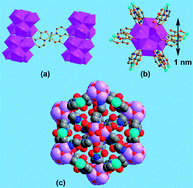Nanosized lanthanide oxide rods in I1O3 hybrid organic–inorganic frameworks involving in situligand synthesis†
Abstract
Presented here are three interesting I1O3 lanthanide-transition metal coordination

* Corresponding authors
a
State Key Laboratory of Structural Chemistry, Fujian Institute of Research on the Structure of Matter, The Chinese Academy of Sciences, Fuzhou, Fujian, China
E-mail:
yyg@fjirsm.ac.cn
Presented here are three interesting I1O3 lanthanide-transition metal coordination

 Please wait while we load your content...
Something went wrong. Try again?
Please wait while we load your content...
Something went wrong. Try again?
L. Chen, J. Zhang, G. Ren, Zhao-Ji Li, Y. Qin, P. Yin, J. Cheng and Y. Yao, CrystEngComm, 2008, 10, 1088 DOI: 10.1039/B804490B
To request permission to reproduce material from this article, please go to the Copyright Clearance Center request page.
If you are an author contributing to an RSC publication, you do not need to request permission provided correct acknowledgement is given.
If you are the author of this article, you do not need to request permission to reproduce figures and diagrams provided correct acknowledgement is given. If you want to reproduce the whole article in a third-party publication (excluding your thesis/dissertation for which permission is not required) please go to the Copyright Clearance Center request page.
Read more about how to correctly acknowledge RSC content.
 Fetching data from CrossRef.
Fetching data from CrossRef.
This may take some time to load.
Loading related content
